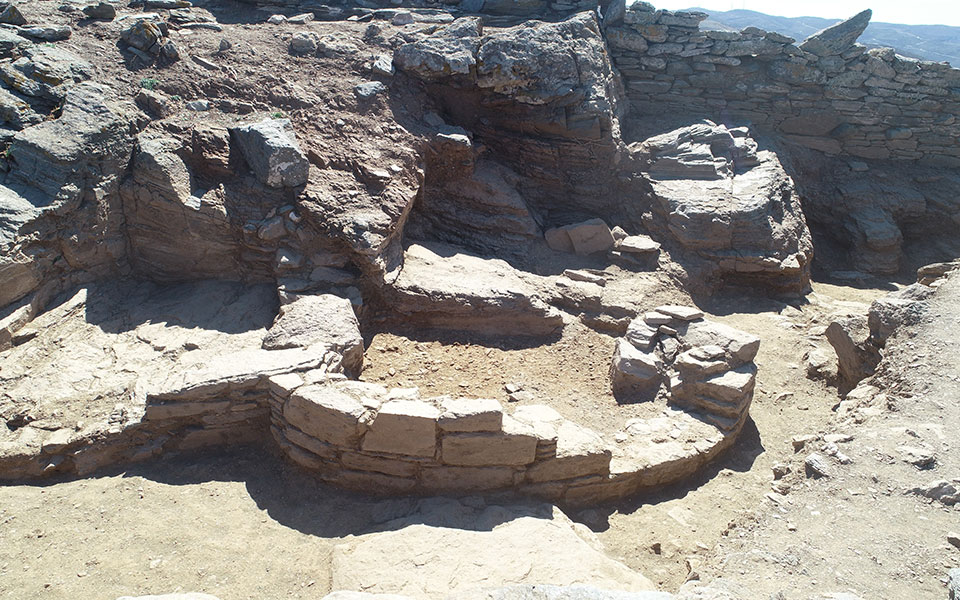
The recent excavation research of the Acropolis of the ancient city of Kythnos (today’s “Vryokastro”), a collaborative project of the Department of Archaeology of the Department of History, Archaeology & Social Anthropology of the University of Thessaly and the Ephorate of Cyclades Antiquities of the Ministry of Culture and Tourism, had significant results.
The city of Kythnos was continuously inhabited from the 12th century BC to the 7th century AD. Work in the last period focused on the excavation of the Acropolis buildings that had come to light in 2021. The southern part of the Acropolis was intended for military installations, undoubtedly including the Macedonian garrison established in Kythnos in 201 BC by Philip V. Only some cleaning was carried out in this area, which revealed a series of cisterns, which provided water supplies in times of siege. The northern part of the plateau is occupied by a sanctuary, which was identified in 2021 with certainty as the sanctuary of Demeter and Koris. Here, investigations continued in three buildings (nos. 3, 4, and 6) and open spaces.
Initially, the investigation of the two-part Building 4, measuring 7.50 x 5.70 m, which is undoubtedly identified with a temple, of the Classical period, was completed. In the western area, in 2021, three cases of upright stone slabs had been found, partly set in a layer of ash containing many burnt animal bones. From the rear (eastern) room (“sanctuary”), also came many bones of small animals, but mainly piglet jaws, incense burners, polychrome lamp vessels, and clay female figurines.
Between this temple and the elongated Building 3 to the south, there are two almost square small buildings, 5 and 6, with opposite entrances. During the last period, the investigation of the western Building 6 (4.85 x 4.25 m.) was completed. The interior is internally arranged in at least three levels. It seems that this was originally the location of the main stepped access to the mosque, which was removed in Roman times and incorporated into Building 6, probably to serve cultic needs (perhaps as a simulation of the descent into Hades?).
The survey was also completed around the perimeter of the earlier Building 5, which is probably also identified with a second smaller temple (3.80 x 3.30 m across) as, as it appeared in 2021, it contained a variety of votive offerings under its top floor. A cared-for paved floor was revealed in the narrow corridor between Buildings 4 and 5, which suggests that these two structures were in use at the same time.
The excavation work, however, focused on Building 3, 21 meters long and 8.50 meters wide. It is characterized by trapezoidal masonry and has a monumental entrance in the middle of the elongated north wall. Two zones of squares were excavated inside the building which allowed its layout to be clarified to some extent. It is noteworthy that most of the sanctuary’s votive offerings come from the abandoned deposits of the building in question. In the eastern part of the building, a series of indented recesses in the natural rock, defined by walls, were revealed, which appear to have formed spaces and ‘compartments’ for the storage and deposition of offerings, as there was a heavy concentration of finds of all categories in these areas. In this part of the building, a stone horseshoe-shaped pit was also uncovered, approx. 2,50 x 2 m, complete with ash and scattered red-hot bricks and with several burnt animal bones, as well as a significant concentration of grave goods. The whole configuration here raises doubts as to whether this part of the structure was sheltered. A large concentration of offerings was also observed in a strip along the rear (south) wall of the western half of the building. From this wall, diagonal flat stones project internally at regular intervals and the same low height, suggesting the presence here of a wooden shelf on which offerings must have been placed.
Between the two temples (nos. 4 and 5) and the elongated Building 3, a mound with an entrance from the east is formed, which at some point during the long period of use of the sanctuary (7th century BC to 3rd – 4th century AD) defined an extensive “depository” which contained innumerable votive offerings. The research here was completed by bringing to light many hundreds of intact or almost intact finds, mainly clay figurines and polychrome lamp vessels.
The exact use and dating of all the buildings uncovered will be determined when the study of the finds and excavation data is completed. In general, the investigation of the interior of the buildings led to the discovery of numerous inscriptions. The bulk, however, came from Building 3 and from the ‘repository’. Many hundreds of Archaic-Hellenistic clay figurines (the intact or nearly intact ones exceeded 2000), female, and children’s figurines were collected; fewer male figurines, especially of actors and sympathizers, hermaphrodite stelae, piglets, turtles, lions, rams, birds, etc. Also collected were just as many lamps of Archaic-Roman times and polychrome ceremonial lamp vessels, ring-shaped “coins” with epithets of miniature vases, numerous epithets of miniature water jars detached from ceremonial vessels, excellent quality ceramics, mainly Attic black and red shaped (jadrias, calpies, etc., ), but also from other laboratory centers (Corinthian, Cycladic, and East Aegean). The votive offerings also include some bronze, silver, bone, and glass jewelry, marble and alabaster vases (flasks, compasses), etc. Some Roman bronze coins were also found (e.g. sestertius of Trajan, after 106 AD, and Diocletian’s coin of 285 AD). However, of particular interest is a silver coin of Kythnos with the head of Apollo on the obverse and a lyre on the reverse, as the Kythnian coins of the Hellenistic period known to date are all bronze.
Several drinking vessels, mainly of Roman times, originating both from inside the temple (Building 4), and from the various deposits within Building 3 and from the “apothecary”, are identified as ritual as they have inscriptions engraved before the firing and are dedications of women, while they confirm that the sanctuary was dedicated to the worship of both Demeter and Koris. Provisionally, we could even assume that Building 4 was the temple of Demeter, while the adjacent smaller Building 5 was that of Koris.
Inside the doorway of Building 3, an inscribed monumental pedestal, measuring 1.43 x 0.47 x 0.21 (thick), was found, moved from its original position, which preserves the inscription of the late Hellenistic period “Niris daμιουργos”, which probably refers to an official of the sanctuary. The use of the Doric dialect confirms once again its parallel use with Ionian in Cyrene.
Many of the above-mentioned votive offerings also refer indirectly or directly to the worship of the two deities, as do various individual finds, e.g. another figurine of a cistus bearer or several fragments of imported Eleusinian coins.
The five-year excavation programme at Vryokastro Kythnos (2021-2025) is being carried out under the direction of Professor of Classical Archaeology Alexandros Mazarakis Aignanos and the Curator of Antiquities Dr. Dimitris Athanasoulis. The investigations of the University of Thessaly and the Cyclades Archaeological Museum of Kythnos are also supported by the General Secretariat for the Aegean and Island Policy, the Municipality of Kythnos, the Association of Friends of the Archaeological Museum of Kythnos, the captain of the ship “MARMARI”, and especially the generous sponsor of the excavation program, Mr. Thanasis Martinos. The interdisciplinary research team of archaeologists, architects, conservators, zooarchaeologists, archaeometers, etc. was accompanied by 33 students of archaeology from the University of Thessaly, as well as two female students from France.

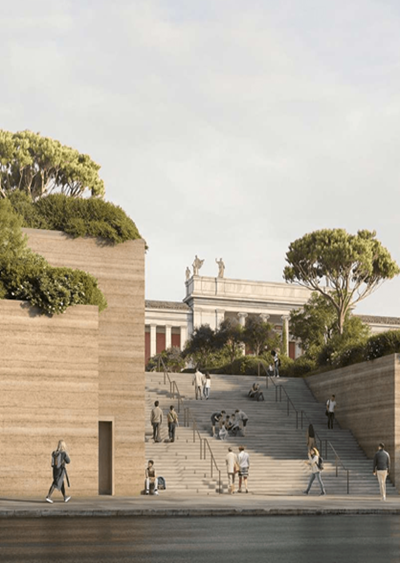
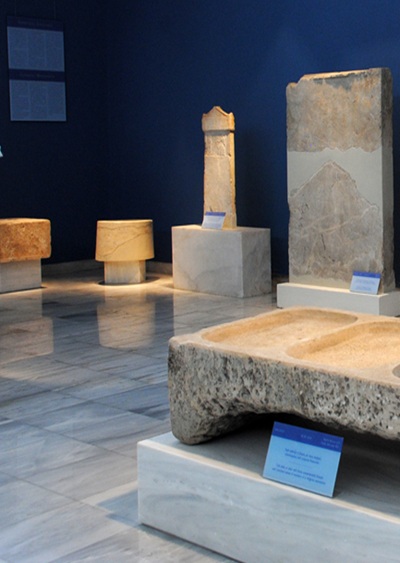
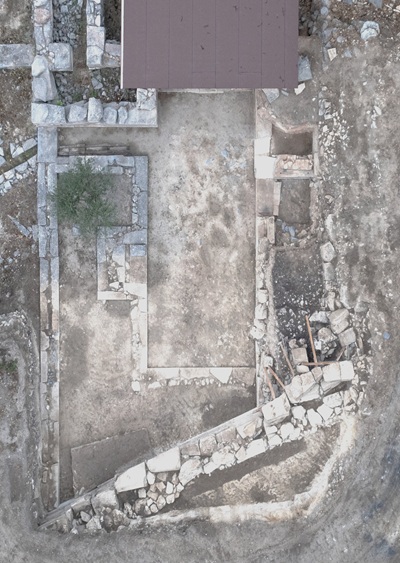
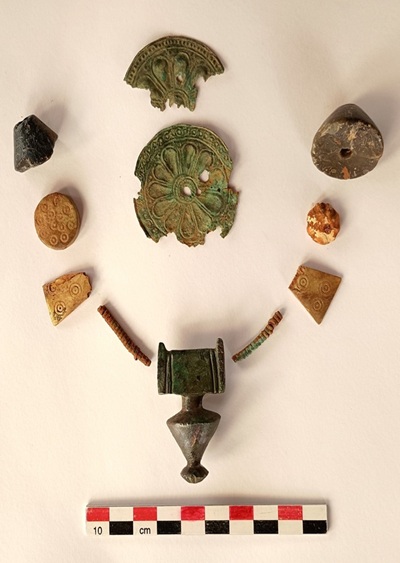


Leave A Comment